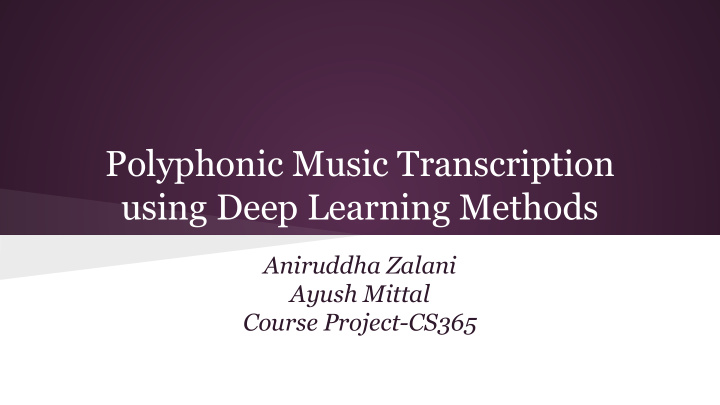



Polyphonic Music Transcription using Deep Learning Methods Aniruddha Zalani Ayush Mittal Course Project-CS365
What is polyphony Two or more independent notes playing at the same time ❖ Monophonic music - only one node is played at a time. ❖
Problem Statement Extract the notes played in a polyphonic piano song. ❖ Resynthesize the song from the transcribed notes. ❖ Many notes are played at once, therefore techniques of multi-class ❖ classifiers are not applicable.
Motivation Many naturally occurring phenomena such as music, speech, or human ❖ motion are inherently sequential. Help in ❖ Plagiarism detection ➢ Artist identification ➢ Genre classification ➢ Composition assistance ➢ Music tutoring system ➢
Related Work Some interesting work has been done using non-negative matrix ❖ factorization techniques [1] and [2]. Poliner and Ellis’ piano transcription system [3] consists of 87 independent ❖ support vector machine (SVM) classifiers However, most of the recent work involve feature learning using deep ❖ learning methods before the classification step.
Related Work ... Juhan et al., [4] trains deep belief network by “greedy layer wise stacking of ❖ RBMs”. They used DBN-based feature representations as input to the linear SVM ❖ for single note and multi note training. They used HMM-based post processing to temporally smooth the SVM ❖ output. We mostly follow the work by Nicholas et al., [5] ❖
Our Approach We focus on two major approaches for learning feature representations: ❖ RNN-RBM based model - ➢ Hessian-free optimization ■ Convolutional Deep Belief Network based model. ➢ In classification step we input features learned from previous step into the ❖ SVM classification method of Poliner and Ellis. Finally, we use HMM for temporal smoothing of the SVM output. ❖
RBM A generative stochastic neural ❖ network that can learn a probability distribution over its set of inputs. Restriction that their neurons must ❖ form a bipartite graph Input units features of their inputs, ❖ Hidden units that are trained. ❖ Contrastive Divergence uses two ❖ tricks to speed up the sampling process:
RNN Connections between units form ❖ a directed cycle RNNs can use their internal ❖ memory to process arbitrary sequences of inputs. Each unit has a time-varying real- ❖ valued activation
RNN-RBM Multimodal Conditional ❖ distribution of v(t) given A(t) where ❖
Dataset Piano midi.de : Classical Piano midi archieve. [6] ❖ Nottingham: i s a collection of 1200 folk tunes with chords instantiated fro, ❖ the ABC format. [7] MAPS: is a large piano dataset that includes various patterns of playing ❖ and pieces of music [8] ~70 hours of polyphonic music. ❖
What we have done?
What work is left? Classification of notes using SVM with features learned from RNN-RBM as ❖ input to SVM. Post processing involving temporal smoothing using HMM and ❖ transcription. Trying out Convolutional Deep Belief Networks for feature discovery. ❖
References [1] Arnaud , Arshia et al. \Real-Time Detection of Overlapping Sound Events with Non-Negative Matrix Factorization" [2] Paris and Judith Non-Negative Matrix Factorization for Polyphonic Music Transcription, IEEE 2003. [3] G. Poliner and D. Ellis: “A discriminative model for polyphonic piano transcription,” EURASIP Journal on Advances in Signal Processing,vol.2007, 2007 [4] J. Nam, J. Ngiam and H. Lee,Classification- Based Polyphonic Piano Transcription Approach Using Learned Feature Representations," ISMIR , pp. 175-180, 2011.
Reference ... [5] N. Boulanger-Lewandowski, Y. Bengio and P.Vincent, Modeling tempo- ral dependencies in high-dimensional sequences: Application to polyphonic music generation and transcription," ICML, 2012. [6] http://www.piano-midi.de/ [7] http://www-etud.iro.umontreal.ca/~boulanni/icml2012 [8] ftps://ftps.tsi.telecom-paristech.fr/share/maps/
CDBN Lee et al.[6] proposed the use of CDBNs ❖ in Music Information Retrieval. ❖
Recommend
More recommend